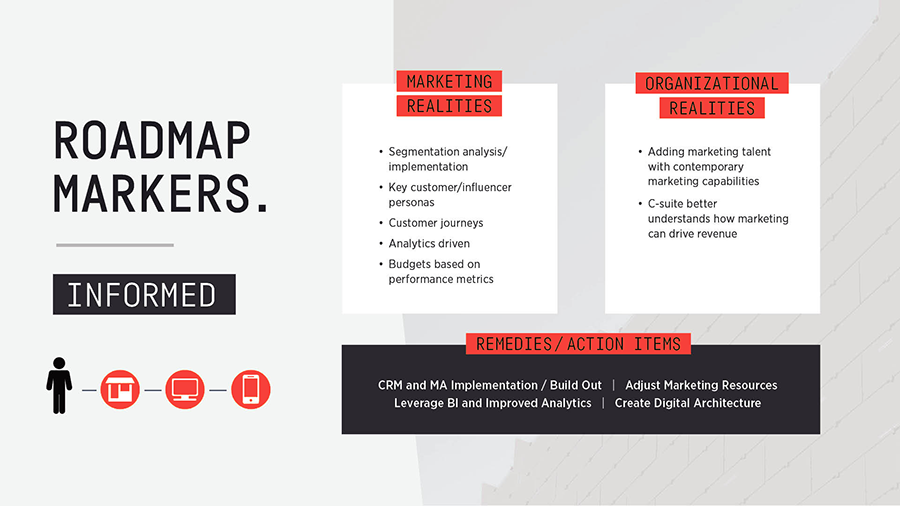
If the uninformed marketer is unaware of its target audience’s interests and concerns and unprepared to effectively engage them about these things with marketing or with a buying experience for that matter, the informed marketer has many of those questions answered.
It’s all part of the customer-focused Digital Marketing Roadmap we’ve shared in recent weeks. The marketing resource categorizes four levels of marketing organizations depending on how well they know their customers and whether or not they’ve aligned the entire organization with that knowledge.
The second stage of the map focuses on the informed marketer, describing an organization that understands what information its customers have accessed and how they’ve found that information. For example, a marketer may be aware when customers have downloaded information from its website, or clicked on an email using their phones.

While this is valuable information, there are gaps in this knowledge. The informed marketer hasn’t connected the dots on which customers are ready to make a purchase and which ones are just looking. The rest of the organization, from sales to operations, also hasn’t aligned itself with the customer journey, although the company now understands there is value in doing this.
Because of these opportunities, the informed marketer has more to learn about the buyer journey its customers will take and more work to do to bring the rest of the organization along for the ride. There are a number of marketing tools the company can implement to do this.
Three big priorities for the informed marketer include creating a digital architecture, implementing customer relationship management (CRM) and marketing automation (MA) tools, and leveraging business intelligence and improved data-driven analytics.
Next-Level Strategies for Informed Marketers
Digital architecture: This diagram or marketing schematic sketches out the buyer’s journey for a specific organization on the behaviors customers go through in making the purchase, and how the company will respond or prepare for these behaviors at each stage, using specific marketing resources.

At the awareness phase of the journey, for example, the organization might use e-newsletters, social media posts, and whitepapers or case studies to build interest and engagement from prospective customers.
Later stages of the journey, like consideration, might call for the use of website pages designed to help customers easily find solutions, product specs, technical data and all the information needed when considering one product against another.
Organizing the company’s marketing activities in this manner helps an organization to segment its activities for the ways customers are considering and buying its products, and allows the company to guide the buyer experience.
Marketing automation and CRM tools: These are the tools that help organizations link specific customers with their behaviors and places in they buyer journey. With marketing automation, organizations can establish nurturing sequences to guide customers along the path to purchase. The tools help ensure that an organization is engaging customers at the right times, using the messaging strategies that are most effective and relevant to them. And incorporating CRM tools helps the organization’s sales reps manage their interactions with customers, allowing them to segment their own communication strategies based on each customer’s place in the buyer journey.
Business intelligence and data analytics: Leveraging user data analytics from sources like Google analytics and other analytics platforms can tell marketers not only which messaging strategies are most engaging to specific customer segments, but also which marketing channels are highest performing. This type of data-driven marketing is beneficial: According to the Kissmetrics blog, companies that have implemented these tools are three times more likely than others to say they’ve achieved a competitive advantage in customer engagement. The key for the informed marketer is selecting business intelligence tools that integrate well with each other and with what they’re already doing.
By implementing these tools, informed marketers will find the information they’re lacking about which customers are learning about its products vs. those that are ready to buy. Which brings us to the Aligned Marketer characterized on the digital marketing roadmap, a type of organization we’ll profile next week.
For more details on any of the stages of the Digital Marketing Roadmap and how to characterize your organization’s efforts, get in touch.